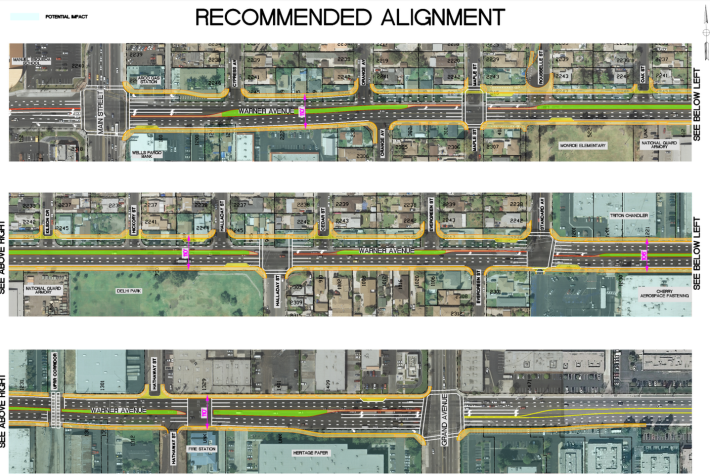
This is what happens when transportation planning focuses on moving cars instead of creating spaces for people.
At the same time that California is aggressively moving to ditch the Level of Service standard that has forced transportation and planning projects to measure and mitigate their impact on car traffic, some projects evaluated under that car-centric system still lumber on at the city and municipality level.
This explains how the City of Santa Ana in Orange County is one step away from approving a massive road widening project on one mile of Warner Avenue through the heart of the city. The plan would widen the already four-lane surface street to six lanes, add planted medians and bicycle lanes, and add ADA accessible street crossings.
The project is being completed to "improve traffic flow and improve safety," according to the city. Worst of all, it is presented as a solution based on complete streets principles. Again, this is what happens when even well-intentioned cities make transportation decisions based first on how it will impact car traffic.
While it is encouraging that the city is committed to increasing its downtown bike network, there is an inherent contradiction between improving traffic flow, i.e. increasing the speed of traffic, and making the street safer for people who walk or bicycle. Speed is a contributing factor in one-third of fatal traffic crashes nationwide. Fast-moving cars on a six-lane street make a daunting obstacle for pedestrians to cross, no matter how nice the planted median is.
The cost of the project is a cool $55 million, 20 percent of which the city already has in hand. Some of that money comes from Orange County's transportation bond, Measure M, which handcuffs how municipalities can spend the money.
For the 37 families that will be displaced by the widening, the cost is much higher. Danny Cortes' family lives at one of the homes Santa Ana plans to purchase for the project. When Cortes learned about the project at community meetings in 2012, his house wasn’t on the list of properties that would be purchased for the project. Only after checking the city’s website in January did he learn that his family would likely be evicted from the place they have called home for over a decade, when the homeowner cashes out.
“It is hard to just leave the place because you have to, when there’s no other option,” Cortes said.
Cortes has been working with Santa Ana Active Streets (SAAS)**, a nonprofit coalition of advocacy groups who push for complete street and smart growth solutions for regional transportation problems. In a document submitted to the city as public testimony, SAAS notes that despite the addition of a bike lane and ADA-compliant street crossings, this plan is not one that will make life safer for street users.
We should note, Santa Ana is not a city led by car centric politicians and a 20th century planning staff. Mayor Miguel Pulido’s recent has signed on to the U.S. Department of Transportation’s “Mayors’ Challenge for Safer People, Safer Streets.” The city just won an award from the Urban Land Institute for its Downtown Transit Zone: Complete Streets Plan to address first mile-last mile connectivity.
But that doesn't mean every project is well thought out. In this case, the city needs to study more options than just the two in their Draft Environmental Impact Statement: Build (the road widening) or No Build (do nothing.)
SAAS is concerned that although the city completed the environmental process, including public meetings, the public neither understands nor supports the project as proposed.
Instead of just scrapping the existing plan completely, SAAS wants the city to study a true complete streets option that looks at what can be done inside of the existing roadways. A delay to consider more options could cost the city some of the $11 million it has on hand for the project, but the savings from moving to a true complete streets design instead of the proposed widening could well exceed that amount.
However, the top concern shouldn't be funding, but whether Santa Ana's city planners want to build a city that is a great place to live, work, and play or a city that one can quickly travel through. The latter is the type of transportation planning that has been done for decades in California and is supported by LOS studies in environmental documents. The latter is what Santa Ana is proposing for a downtown that is winning accolades from local advocates and regional planning organizations.
The City Council of Santa Ana is tentatively scheduled to vote on certifying the environmental documents, the last step before seeking the rest of the funding, on May 5.
** Disclosure: We were first alerted to this story by former Streetsblog Los Angeles writer Kris Fortin, who works with SAAS.





